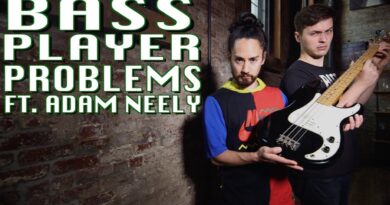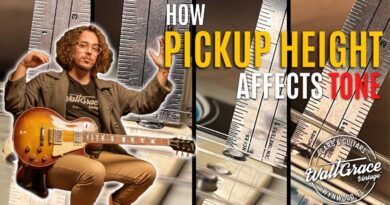How to fix Time Alignement Phasing Problems ? – Best kept Live Sound secrets ????
#fohengineer #inearmonitors #sounddesign
Join this channel to get access to perks:
https://www.youtube.com/channel/UCZsYgXp59CDcI33OJpVePBw/join
To support the channel please become a Member or a Super Member or Paypal : https://paypal.me/GLortie
Email : info@guillaumelortie.com
Main Gear List and amazon.ca affiliate links : https://amz.run/6ahU
Behringer WING : https://amz.run/6ah9
Midas DL 251 Stagebox : https://amz.run/6ahB
My live microphone : https://amz.run/6ahD
In-Ear Monitor : https://amz.run/6ahE
Headphones : https://amz.run/6ahF
Audio Interface : https://amz.run/6ahJ
#iem #audio #gear #live #delay #musician #monitor #show #professional #time #alignment
#fix #Time #Alignement #Phasing #Problems #Live #Sound #secrets
Originally posted by UCZsYgXp59CDcI33OJpVePBw at https://www.youtube.com/watch?v=2aExZqv1Fs8




How do you measure the delay, in both the in ear and the wedge monitor. If you doing front house mixing with no monitor console?
Been saying this for years. Thank you. Some people act like I've offended their ancestors when I suggest something like this.
Perfectly explained! You got a new sub 🙂
Playing with one in ear monitor csn cause early problems of deafness. This os due to the off balance of information and people tend to send the signal higher to compensate when they have one ear in. If he needs atmosphere feedback, crowd mics are best. You did however provide a good solution
I imagine this will only work in exactly one place and will change between soundcheck and when the venue gets warm and moist from all the people, or are the delays so small it doesn't really matter?
Modern digital console has delay compensation. Do I still add ~ 6ms delay IEM?
This is so bang on, Im almost in tears! Excellent job Guillaume!
Great information, for sure. Thanks for taking the time and trouble to make the video. I wonder if the reason that the artist uses only one side of the IEM is so that he/she can hear the acoustics and the audience response, in which case ambient mics in the IEM mix would help.
Also, as a performer myself in the past, I didn't care about stereo, much less about "mapping" the sources with panning in IEMs. All I cared about was the proper blend. I did appreciate ambient mics.
What happens when he steps back or moves his head. It all goes out the window. I think you’re playing more with Haas effect than phase cancellation. How is the right ear cancelling if it doesn’t hear exactly what the left ear does and vice versa. Different drivers, different volumes etc?
So you are saying that phase cancelation happens in the brain? Not so sure about that. Electrical and acoustic interference is fact, but saying phase cancelation happens in the brain is new. Any proof?
Have you considered the third source that interferes with the singer’s own vocals — his own voice through bone conduction?
While aligning the in-ear to the arrival of the wedge, say 6 ms, you will also push his own vocals in the in-ears 6 ms away from the “voice inside his head.”
A typical IEM digital console latency of 3 ms would put the first comb filter dip at 167 Hz, three dips under 1 kHz. (5 ms: 100 Hz, five dips under 1k). No idea of the severity, not familiar with the ratio of the in-ear vocal SPL to the bone conduction SPL.
One long shot hypothesis is that adding those 6 ms extra will pack nine dips between 56 Hz and 944 Hz, and in some way counteract the occlusion effect (due to blocking the ear canal) that has its prominent 10-15 dB bump in that same frequency range.
– Would love to hear the singer comment on how the introduction of delay affects his own vocal monitoring in isolation. Feel out the characteristics of different amounts of delay, flip polarity, experiment with other ways to counteract occlusion effect …
yes, "Comb-Filtering" excellent concept!
Yes!! Thanks for sharing that. What about when a guy has a floor wedge and his amp right behind him. What’s the solution for that? Most festivals these guys are not using IEMs
Maybe tell the person onstage that if they wear only one ear, they will permanently destroy their hearing?
Great observation! ????????
why still need wedge if wearing IEM? Does that defeat the purpose of lowering stage volume with IEM?
I wonder if this is the problem that Latin pop singer Luis Miguel has… in fan shot videos, you can often see him going to the edge of the stage and fighting with the monitor engineer. There is even one video of a live show in Panama where he went to the edge of the stage and threw his mic at the monitor engineer… ????????????????. He's known to be a real d!ck to work with, but perhaps there is at least a partial reason for his completely unacceptable behavior. You can clearly see that he only wears his right in-ear in many situations. The problem would be that we wanders all around the stage, so getting an acceptable delay time would be much more difficult than for a singer who stays in one place.
Also, well heeled musicians should strongly consider custom molded in-ears… this ensures a perfect seal with the ear, and drastically improves bass response. With the exception of drummers & bassists, custom fit in-ears can usually eliminate the need for any additional bass from floor monitors or stage fills. The first time you wear them, it feels like an alien dragon inserted her tongue in your ear, but you get over it quickly, and that "loving" fit ensures they never fall out.
Excellent vidéo, c'est vraiment un game changer !!
J'adore le bout @7:38 et entendre le problème , anti-ASMR au boute ahaha 🙂
comment a tu calculer le delais par mesure physique ( tape mesure) ou Smaart mesure?
What about the physical damaged cause by the double exposure? One part of the signal being louder than the other?